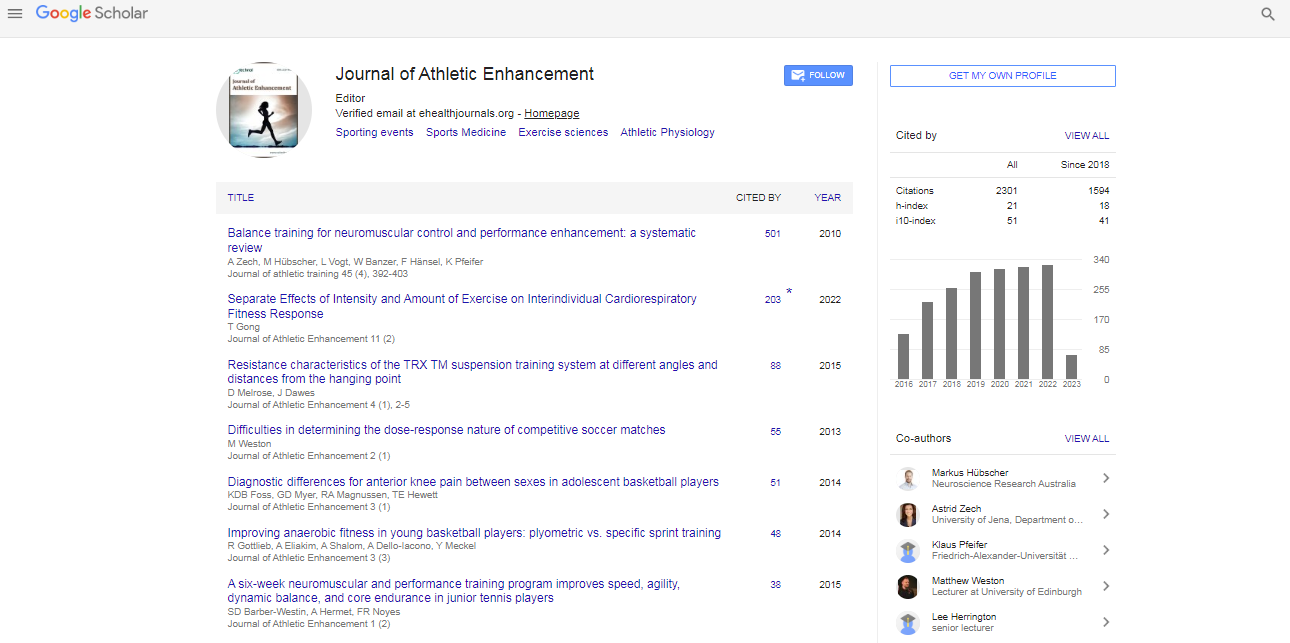Commentary, J Athl Enhanc Vol: 13 Issue: 3
The Impact of Physical Activity on Health and Well-Being
Ricardo Marie*
1Department of Sport Science, The University of Queensland, Brisbane, Australia
*Corresponding Author: Ricardo Marie,
Department of Sport Science, The
University of Queensland, Brisbane, Australia
E-mail: mariericardo@edu.au
Received date: 26 April, 2024, Manuscript No. JAE-24-137838;
Editor assigned date: 29 April, 2024, PreQC No. JAE-24-137838 (PQ);
Reviewed date: 14 May, 2024, QC No. JAE-24-137838;
Revised date: 20 May, 2024, Manuscript No. JAE-24-137838 (R);
Published date: 27 May, 2024, DOI: 10.4172/2324-9080.1000126
Citation: Marie B (2024) The Impact of Physical Activity on Health and Well-Being. J Athl Enhanc 13:3.
Description
In the world marked by sedentary lifestyles and the omnipresence of technology, the significance of physical activity cannot be overstated. From its impact on physical health to its profound effects on mental well-being, the realm of physical activity is a vast landscape encompassing myriad benefits. The human body is intricately designed to thrive on movement. Physical activity serves as a cornerstone for maintaining optimal physiological functioning. Regular exercise has been unequivocally linked to a myriad of health benefits, including but not limited to cardiovascular health, weight management, and enhanced immune function. Engaging in aerobic activities such as jogging, swimming, or cycling not only strengthens the heart and lungs but also improves circulation, thereby reducing the risk of chronic diseases such as heart disease, stroke, and diabetes.
Moreover, resistance training, encompassing exercises like weightlifting or bodyweight exercises, plays a pivotal role in building and maintaining muscle mass and bone density. This is particularly important in combating age-related muscle loss and osteoporosis. Physical activity also stimulates the release of endorphins, neurotransmitters responsible for inducing feelings of euphoria and alleviating stress and pain. This natural moodenhancing effect can significantly contribute to an individual's overall sense of well-being. Beyond its physiological ramifications, physical activity exerts a profound influence on mental health and cognitive function. Research has consistently demonstrated the positive impact of exercise on mood regulation, stress reduction, and anxiety management. Engaging in regular physical activity has been shown to alleviate symptoms of depression by promoting the release of serotonin and dopamine, neurotransmitters associated with feelings of happiness and relaxation.
Furthermore, exercise serves as a powerful tool for enhancing cognitive function and neuroplasticity. Aerobic activities have been shown to improve memory, attention, and executive functioning by promoting neurogenesis and synaptic plasticity in key brain regions such as the hippocampus and prefrontal cortex. The cognitive benefits of physical activity extend across the lifespan, from facilitating optimal brain development in children to mitigating age-related cognitive decline in older adults. In addition to its physiological and psychological effects, physical activity fosters social connections and promotes a sense of community. Whether through team sports, group fitness classes, or outdoor recreational activities, exercise provides opportunities for social interaction and camaraderie. These social bonds not only enhance motivation and accountability but also contribute to a sense of belonging and support network.
Moreover, physical activity serves as a platform for self-expression and personal growth. Engaging in challenging physical endeavors cultivates resilience, perseverance, and self-confidence. Whether conquering a difficult yoga pose or completing a marathon, the sense of accomplishment derived from pushing one's physical limits transcends into other areas of life, bolstering self-esteem and selfefficacy. Despite the plethora of benefits associated with physical activity, incorporating regular exercise into one's lifestyle can pose challenges. Busy schedules, lack of motivation, and accessibility barriers are common impediments to maintaining a consistent exercise regimen. However, adopting a holistic approach encompassing varied forms of physical activity can help mitigate these obstacles.
It is essential to find activities that resonate with individual preferences and interests, whether it be dancing, hiking, or practicing martial arts. By cultivating enjoyment and intrinsic motivation, adherence to an exercise routine becomes more sustainable in the long term. Additionally, integrating physical activity into daily routines, such as walking or cycling for transportation, can help overcome time constraints while promoting incidental exercise.
Furthermore, leveraging social support networks and accountability mechanisms, such as exercising with a friend or joining a fitness community, can enhance motivation and adherence. Setting realistic goals and tracking progress allows for a sense of achievement and momentum. Additionally, prioritizing recovery and rest is important for preventing burnout and injury, emphasizing the importance of adequate sleep, nutrition, and hydration. Physical activity is a multifaceted phenomenon with far-reaching implications for human health and well-being. From its physiological benefits in promoting cardiovascular health and immune function to its profound effects on mental health and cognitive function, the transformative power of exercise cannot be overstated. Moreover, physical activity serves as a catalyst for social connection, personal growth, and self-expression, fostering a holistic sense of well-being. By embracing a balanced approach that encompasses varied forms of physical activity and prioritizes individual preferences and needs, individuals can unlock the full potential of physical activity to enhance their quality of life.
 Spanish
Spanish  Chinese
Chinese  Russian
Russian  German
German  French
French  Japanese
Japanese  Portuguese
Portuguese  Hindi
Hindi 
